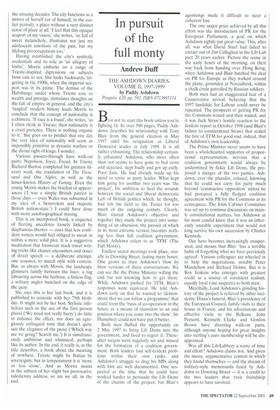In pursuit of the full monty
Andrew Duff
THE ASHDOWN DIARIES, VOLUME II, 1997-1999 by Paddy Ashdown Penguin, £20, pp. 592, ISBN 0713995114 Best not to start this book unless you're fighting fit. In over 500 pages, Paddy Ashdown describes his relationship with Tony Blair from the general election in May 1997 until his resignation as Liberal Democrat leader in July 1999. It is all rather exhausting. The relationship certainly exhausted Ashdown, who more often than not seems to have gone to bed cross and dejected, slept badly and got up early. Poor Jane. He had already made up his mind to retire as party leader. What kept him going for another two years was 'the project', his ambition to heal the wounds between the social and liberal democratic Left of British politics which, he thought, had left the field to the Tories for too much of the outgoing century. Clearly, Blair shared Ashdown's objective and together they made the project into something of an obsession, the pursuit of which in its most extreme version becomes nothing less than full coalition government, which Ashdown refers to as `TFM' (The Full Monty).
Endless secret meetings took place, usually in Downing Street, lasting many hours. One grows to trust Ashdown's blow by blow versions of these conversations. We can see the the Prime Minister willing the end but not knowing how to get there. While Ashdown pushed for TFM, Blair's responses were equivocal. He told Ashdown early on that he wanted to 'demonstrate that we can follow a programme' that could form the 'basis of co-operation in the future as a means of transition to an end position where you come into the show'. Sir Humphrey could not have put it better.
Both men fluffed the opportunity on 2 May 1997 to bring Lib Dems into the government, and lived to regret it. Thereafter targets were regularly set and missed for the formation of a coalition government. Both leaders had self-evident problems within their own ranks, and Ashdown's struggle to drag his MPs along with him are well documented. One suspected at the time that he could have worked harder to persuade the Lib Dems of the charms of the project. but Blair's agonisings made it difficult to steer a coherent line.
The one major prize achieved by all this effort was the introduction of PR for the European Parliament, a goal on which Ashdown rightly put great value. This, after all, was what David Steel had failed to extract out of Jim Callaghan in the Lib-Lab pact 20 years earlier. Picture the scene in the early hours of the morning, on their way back from handing over Hong Kong, when Ashdown and Blair hatched the deal on PR for Europe as they walked around the plane, grounded at Novosibirsk, within a chalk circle patrolled by Russian soldiers.
Both men had an exaggerated fear of a Conservative revival, believing that the 1997 landslide for Labour could never be repeated. The prospects of getting PR for the Commons waxed and then waned, and it was Jack Straw's hostile reaction to the Jenkins report in October 1998 (and Blair's failure to countermand Straw) that sealed the fate of TFM for good and, indeed, that of Ashdown's own leadership.
The Prime Minister never seems to have been a wholehearted supporter of proportional representation, nervous that a coalition government would always be undermined by fickle Lib Dems. He proposed a merger of the two parties. Ashdown, ever the pluralist, refused, knowing that he could not carry his party much beyond 'constructive opposition' unless he had procured a fully fledged coalition agreement with PR for the Commons as its centrepiece. The Joint Cabinet Committee was set up to continue discussions on mainly constitutional matters, but Ashdown at his most candid knew that it was an inherently unstable experiment that would not long survive his own succession by Charles Kennedy.
Our hero becomes increasingly exasperated, and moans that Blair 'has a terrible habit of forgetting what we have previously agreed'. Various colleagues are wheeled in to help the negotiations, notably Peter Mandelson and Richard Holme. But it is Roy Jenkins who emerges with greatest credit as a source of consistent realism, equally loyal (one suspects) to both men.
Mercifully, Lord Ashdown's grinding history of the project is relieved by other incidents: Diana's funeral, Blair's presidency of the European Council, family visits to their house in France, and his adventurous and effective visits to the Balkans. John Prescott, Kenneth Clarke and Gordon Brown have diverting walk-on parts, although anyone hoping for great insights into sterling's euro membership will be disappointed.
Was all this Lib/Labbety a waste of time and effort? Ashdown claims not. And given the messy, argumentative context in which they found themselves — and the stream of military-style memoranda faxed by Ashdown to Downing Street — it is a credit to the two leaders that their friendship appears to have survived.










































































 Previous page
Previous page